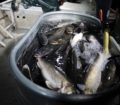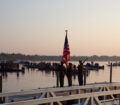By Jason Mitchell
 For many walleye fishing enthusiasts, spring walleye runs are the first game each season. Each river system has its own intricacies and nuances. There are obviously differences between river systems, and each system has a unique personality. Regardless of river system, the most important component of fishing rivers for walleyes in my opinion is simply being flexible and nimble. Fishing on the fly and adjusting to the day is perhaps more important on a river than anywhere else you might fish for walleye.
For many walleye fishing enthusiasts, spring walleye runs are the first game each season. Each river system has its own intricacies and nuances. There are obviously differences between river systems, and each system has a unique personality. Regardless of river system, the most important component of fishing rivers for walleyes in my opinion is simply being flexible and nimble. Fishing on the fly and adjusting to the day is perhaps more important on a river than anywhere else you might fish for walleye.
Expect changing conditions
On many river systems, conditions can change through the day as current velocity pulses or changes. Water clarity can be a moving target. On top of the changes in the river itself, the fish are going through major changes.
Typically before the spawn, we often find fish holding in holes of troughs of deeper, slower water. These spots can often be community spots and what is interesting is that some of the first boats on the water each spring often do well in these types of locations, but these locations often fall off quickly as boats show up.
Warming trends and sunshine can push fish up shallow but fronts or dips in water temps can pull fish down deeper. After the spawn, we will sometimes find fish out of the current more especially if there is sunshine and a warming trend. How fish position on a current seam can change by the hour.
If you fish a river in August, you might be looking for the fast water or the top wing dam. Early in the season, however, we often find fish relating to slower current or a seam where fast water meets slack water. Use your trolling motor to feel the pattern. If you need to have your trolling motor on five or six to pull ahead against the current, you might be in too fast of water. Don’t rely on ground speed when fishing a river as there is no magic speed to slip downstream or drag upstream. Use the power of the trolling motor to read the current velocity.
Few presentations catch more fish on a river system than a jig. Jigs and minnows traditionally catch plenty of fish and there are times when using real meat can catch more fish, especially when you have to slow down in real slack water. So often, however, jigs and soft plastics just make you more efficient.
On most river systems with many walleye anglers, soft plastics are the first choice. Soft plastics put off more vibration, are durable and you can adjust the glide, profile and color. You can simply fish through locations faster with soft plastics because of the durability.
Because conditions can change by the hour on a river, you can simply sample so much water by pitching. You can touch the shallow water and still fish the water back to the boat and fish below the boat. Not only are you working the jig through different depths, you are also moving the jig through the seam and touching different current velocities as well. As you learn the location and fine tune the exact location where fish are holding, you can focus on boat position and find the perfect angle to cast to keep the jig in front of fish. Usually, the aggressive fish are positioned nosed into the faster water next to the seam or near the top or upstream portion of the slot or hole.
Some bottoms have a sawtooth type bottom that will hold several small nooks or depressions where fish can lay like what we often see on the Rainy River. Horizontal seams and eddies that can be visually seen are often a perfect candidate for pitching where as big river bends, holes or locations that feature up and down structure that slow down current below are perfect for dragging jigs upstream or slipping downstream. Regardless of seam or location, jigs and plastics can often shine.
Pitching jigs
For pitching across the seam or cross current, thin diameter lines and narrow plastic profiles often fish better as you don’t want the current to bow the line or push the plastic too fast downstream. For pitching plastics, I absolutely love Berkley Nanofil. Nanofil is a super thin braid that offers no stretch so this line not only cuts current extremely well but is also very sensitive and responsive. I often use a two to three foot piece of fluorocarbon leader material tied to the Nanofil with an Alberto Knot.
I believe that high vis line that is easier to see gives an angler a big advantage for pitching jigs on rivers because you can watch the line. Not only watch the line jump from a fish but also watch the bend in the line. Too much bend in the line will cost you fish, so you have to change your jig weight or angle of cast to find that sweet spot.
What I also like to do with high vis braided line is run a black sharpie down the line just to make the high vis line disappear better underwater. When we film underwater footage in a river, the amount of leaves, grass and debris that is tumbling downstream is significant. I really believe the walleye learn to ignore stuff floating past them that looks like debris.
High vis line looks a lot like this debris underwater and by just darkening the line above the leader, the whole package as far as the line seems to be much harder to see. Particularly when you have good water visibility which often coincides with some of the best river fishing, using an invisible leader material and darkening the high vis braid above the leader is something that can mean more bites and more fish.
For plastics, think aerodynamic when pitching. Narrow and compact, current cutting profiles like ring worms, flukes or narrow paddle tails like the Salmo Slick Shad often fish better in current. Wide profiles or bulky profiles just don’t find bottom and often get pushed downstream faster. For fishing faster water or seams, the Salmo Slick Shad has emerged as my favorite.
In fact, I caught the biggest walleye I have ever caught last spring using a Slick Shad by pitching an eddy off a submerged sandbar on the Missouri River in North Dakota. Other notable profiles include some of the ribbed paddle tail styles that exaggerate the profile but cut down on the bulk. Examples of these ribbed or spiked profiles include the B-Fish-N Pulse-R or the Salmo Spikey Shad.
Dragging jigs
For dragging jigs upstream, I often find that I can get away with some bulkier profiles and sometimes find that the larger profiles work better in dirtier water. My favorite all around soft plastic body profile for dragging jigs is the Scheels Pro Swimmer which is your typical round grub style body with a big thumper paddle tail. You can pitch the Pro Swimmer in light to moderate current but where it really shines is dragging upstream in faster current. Perhaps the biggest reason I like to drag upstream so much is because I can crawl slower than slipping with the current downstream and the paddle tail moves a lot of water and puts off vibration. Especially when there is rain, ice jams or tributaries muddying up the water and cutting down visibility, dragging big paddle tail plastics upstream is a go to tactic.
Regardless of plastic, don’t be afraid to use jig with a stout long shank hook. Also, if you typically use a jig and minnow and don’t have confidence with plastics or want to get confidence with plastics, increase the size of your jig at least one to two sizes when you switch from live bait to plastics.
Plastics just usually take a little more weight to find bottom. In fact, when I am looking for fish and just trying to figure out the day, I like to error on the side of heavy just so I can cover a lot of different water. When I don’t know where the fish will be, I use the heaviest jig I can get away with. Once I find fish, I like to use the lightest jig I can get away with. The Northland Fishing Tackle Slurp! Jig Head is a great long shank hook for pitching. For stronger current, Clam makes a tungsten round headed jig with a long hook shank called the Drop TG that is phenomenal for faster or deeper water.
If you were to poll many walleye anglers, I would have to believe that pitching a jig to catch a walleye would rate at the top of any list for simply a fun way to catch fish. In my opinion, plastics make pitching jigs even more fun. Especially when using braid, the bites are often electric. The strikes can be so hard. Fish hit these plastics hard and there is often no question that you got bit. Besides being simply fun, plastics are so effective and versatile. There is no doubt in my mind that you will catch more walleye this spring if you get confidence in soft plastics.
















